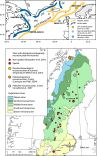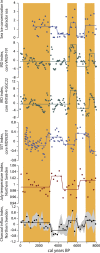Atlantic SSTs control regime shifts in forest fire activity of Northern Scandinavia
- PMID: 26940995
- PMCID: PMC4778016
- DOI: 10.1038/srep22532
Atlantic SSTs control regime shifts in forest fire activity of Northern Scandinavia
Abstract
Understanding the drivers of the boreal forest fire activity is challenging due to the complexity of the interactions driving fire regimes. We analyzed drivers of forest fire activity in Northern Scandinavia (above 60 N) by combining modern and proxy data over the Holocene. The results suggest that the cold climate in northern Scandinavia was generally characterized by dry conditions favourable to periods of regionally increased fire activity. We propose that the cold conditions over the northern North Atlantic, associated with low SSTs, expansion of sea ice cover, and the southward shift in the position of the subpolar gyre, redirect southward the precipitation over Scandinavia, associated with the westerlies. This dynamics strengthens high pressure systems over Scandinavia and results in increased regional fire activity. Our study reveals a previously undocumented teleconnection between large scale climate and ocean dynamics over the North Atlantic and regional boreal forest fire activity in Northern Scandinavia. Consistency of the pattern observed annually through millennium scales suggests that a strong link between Atlantic SST and fire activity on multiple temporal scales over the entire Holocene is relevant for understanding future fire activity across the European boreal zone.
Figures






Similar articles
-
Contingent Pacific-Atlantic Ocean influence on multicentury wildfire synchrony over western North America.Proc Natl Acad Sci U S A. 2007 Jan 9;104(2):543-8. doi: 10.1073/pnas.0606078104. Epub 2006 Dec 29. Proc Natl Acad Sci U S A. 2007. PMID: 17197425 Free PMC article.
-
Holocene centennial to millennial shifts in North-Atlantic storminess and ocean dynamics.Sci Rep. 2018 Aug 24;8(1):12778. doi: 10.1038/s41598-018-29949-8. Sci Rep. 2018. PMID: 30143649 Free PMC article.
-
Dispersal limitation drives successional pathways in Central Siberian forests under current and intensified fire regimes.Glob Chang Biol. 2016 Jun;22(6):2178-97. doi: 10.1111/gcb.13181. Epub 2016 Mar 8. Glob Chang Biol. 2016. PMID: 26649652
-
The North Atlantic subpolar gyre and the marine migration of Atlantic salmon Salmo salar: the 'Merry-Go-Round' hypothesis.J Fish Biol. 2010 Aug;77(3):435-67. doi: 10.1111/j.1095-8649.2010.02673.x. J Fish Biol. 2010. PMID: 20701633 Review.
-
Reconstruction of fire regimes through integrated paleoecological proxy data and ecological modeling.Front Plant Sci. 2015 Jan 22;5:785. doi: 10.3389/fpls.2014.00785. eCollection 2014. Front Plant Sci. 2015. PMID: 25657652 Free PMC article. Review.
Cited by
-
Persistent multi-scale fluctuations shift European hydroclimate to its millennial boundaries.Nat Commun. 2018 May 2;9(1):1767. doi: 10.1038/s41467-018-04207-7. Nat Commun. 2018. PMID: 29720588 Free PMC article.
References
-
- Bowman D. M. et al. Forest fire management, climate change, and the risk of catastrophic carbon losses. Front. Ecol. Environ. 11, 66–68, doi: 10.1890/13.WB.005 (2013). - DOI
-
- Amiro B. D. et al. Fire weather index system components for large fires in the Canadian boreal forest. Int. J. Wildland Fire 13, 391–400, doi: 10.1071/WF03066 (2004). - DOI
-
- de Groot W. J. et al. A comparison of Canadian and Russian boreal forest fire regimes. Forest Ecol. Manag. 294, 23–34, doi: 10.1016/j.foreco.2012.07.033 (2013). - DOI
-
- van der Werf G. et al. Global fire emissions and the contribution of deforestation, savanna, forest, agricultural, and peat fires (1997–2009). Atmos. Chem. Phys. 10, 11707–11735, doi: 10.5194/acp-10-11707-2010 (2010). - DOI
Publication types
LinkOut - more resources
Full Text Sources
Other Literature Sources

